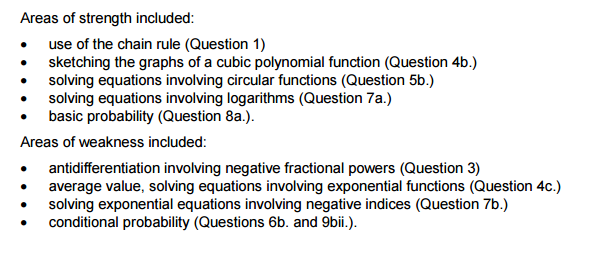Maths Methods is a tricky subject, especially when the assessors are so damn finicky about how you write your answers. As such, we’re bringing you some Maths Methods advice to get you through your next assessment and best prepare you for the exams.
Graphs
• ALWAYS label key features (i.e. axes, intercepts, asymptotes, endpoints, cusps, etc.)
• When labeling coordinates on graphs, always write it as (2, 0) and not simply ‘2’. The same rule applies for intercepts between graphs.
• Asymptotes and similar key features need to be labelled as y=6, not just ‘6.’ Also, make sure the dotted line is visible and that the graph does not touch or cross the asymptote! Even if you have stated that there is an asymptote at y=6, if your graph shows the function touching or crossing the line, you can lose a mark.
• Be careful with restricted domains! This is a favourite VCAA trick! Clearly label the included (closed circles) and excluded (open circles) endpoints.
• Remember that you cannot define a function at an endpoint, even if it is included!
• When drawing cusps, make sure they are ‘pointy.’ The clearer such features are, the easier it is to get the mark.
Accuracy of Answers
• Give exact values unless instructed otherwise. Every year, the assessors remark that students lose marks for failing to do this!
• For worded and/or extended response questions, be sure to convert your answer and express it in the proper form. For instance, if a question asks ‘how many hours…’ and you just write 8/3, you won’t get a mark for your answer. You’d have to say ‘2 hours and 40 minutes.’ 2.67 hours would also be unacceptable.
• If two decimal place accuracy is required (and it usually is!) and your calculator gives you something like ‘8.401’ then your answer should be ‘8.40’ and DEFINITELY NOT ‘8.4’. I don’t know why, but I once lost a mark over this and the angry red scribbles of my methods teacher are still burned into my retinas.
• Though VCAA (allegedly) try to avoid these kinds of traps, be careful not to use rounded answers for later questions. For example, if part a) of a question asks you to find variable ‘k’ which equals 17.8263, and you round it to 17.83, be sure to use the original/exact value of ‘k’ in parts b) onwards unless otherwise specified. (Sidenote: after a minor debacle back in 2009 (Question 3, part c) of Exam 2, if you’re curious) VCAA have never made this mistake again. I believe they ended up accepting both answers for part c) (i.e. the one that used the rounded variable and the exact value) but if in doubt, go for the original, unrounded version.) You can add this kind of Maths Methods advice to your bound reference book if you want, since it’ll likely be more relevant for Exam 2.
• If a question asks you to find a formula or rule, be sure to write:
and not just:
Hence… & Show that…
• If a question begins with the word Hence… it means that you need to use your answer from the previous question!
• If a ‘hence…’ question is worth one mark, you will not get that mark unless you have used a formula or variable from the preceding question.
• For Show that… questions, do most of your working by hand, and try to only use your calculator when you need to get an exact/decimal answer.
Functions
• Note that full function notation. includes:
where [0,5] is the domain and -|x-3|+2 is the function
• If asked to define a function, you need to give the domain, but you don’t need to use full function notation unless otherwise specified.
• Use the correct wording when talking about dilations. Make sure you know the difference between ‘a dilation of a factor 2 from the x axis’ and ‘a dilation of factor 1/6 from the y axis.’ Don’t mix up those prepositions either, since ‘a dilation of factor 2 in the x axis’ is not the same as one from the x axis.
• Transformations can affect the domain and range. Double check the restrictions if you need to.
• Know your general solutions, and remember to specify n ∈ Z
• For integrals: DON’T FORGET THE dx
• AND DON’T FORGET THE +c
General Maths Methods Advice
• The denominator of a power is the same as the degree on a √ sign. i.e.
• Don’t forget basic things like the Change of Base Rule. i.e.
• Don’t confuse things like the average value of a function with the average rate of change.
• Know your log laws, and don’t incorrectly cancel log functions.
• Watch out for basic arithmetical mistakes. Always be extra careful when converting fractions, expanding or factorising equations, and even with really simple processes like addition and multiplication. Don’t be like me and lose marks for ridiculous errors like ‘8+8=12’ or ‘3+3=3.’
• Take note of the common areas of weakness in last year’s assessor’s report. These kind of questions are highly likely to come up again.
• I’m not kidding. I actually wrote 3+3=3 on one of my SACs. My best piece of Maths Methods advice: check your workings, or face eternal shame.
• Also watch out for the ol’ ± trick:
• If you need more specific Maths Methods advice for the topics you’re studying, check out our Methods Resource Megathread!












